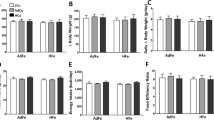Abstract
We previously observed a rapid reduction in plasma ceruloplasmin activity in lean Zucker (Fa/Fa) rats fed a marginal copper (Cu)-deficient diet compared to similarly fed obese Zucker (fa/fa) and lean Sprague-Dawley rats. In an effort to understand the mechanisms underlying this response, we utilized the isotope dilution method to investigate the absorption and excretion of Cu in lean Zucker rats fed control and marginal Cu diets. Sprague-Dawley (SD) and homozygous lean Zucker rats were fed either a Cu-adequate (Cont; 7.5 μg Cu/g diet) or a low Cu (Low; 1.1 μg Cu/g diet) casein-based diet for 23 d. Two weeks following initiation of the dietary treatment, each rat was injected intramuscularly (im) with 11.2 μCi of67Cu. Urine and feces were collected daily. On the 9th d following isotope injection, rats were killed and tissues collected. Significant dietary effects were observed in the relative absorption and endogenous fecal excretion of67Cu. The tissue distributions of nonisotopic Cu and67Cu activity were also different between dietary treatments. Tissues from rats fed the low-Cu diet typically had high concentrations of67Cu and low concentrations of nonisotopic Cu compared to controls. An increase in relative67Cu absorption was evident for rats fed the low-Cu diet (57.2 and 39.3%, for SD Low, Zucker Low, respectively, and 17.9, and 28.5% SD Cont and Zucker Cont, respectively). Rats fed the low-Cu diet also had reductions in endogenous fecal excretion of67Cu compared to their respective controls. Although strain effects were not evident for either percent Cu absorption or endogenous fecal Cu excretion, the relative adaptive changes appeared more marked for the Sprague-Dawley rats compared to the lean Zucker rats.
Similar content being viewed by others
References
C. L. Keen, K. L. Olin, M. H. Oster, D. C. Thurmond, B. J. German, J. S. Stern, and S. D. Phinney, The obese Zucker rats (fa/fa) and its lean control (Fa/Fa) are characterized by marked differences in the antioxidant defense system, TheFASEB J. 6, A1677 (abstract) (1992).
S. M. Lynch and L. M. Klevay, Contrasting effects of a dietary copper deficiency in male and female mice,Proc. Soc. Exp. Biol. Med. 205, 190–196 (1994).
M. Suzuki and T. Aoki, Impaired hepatic copper homeostasis in Long-Evans Cinnamon rats: reduced biliary excretion of copper,Ped. Res. 35, 598–601 (1994).
N. Sugawara, M. Katakura, D. Li, C. Sugawara, and H. Miyake, Role of hepatic copper-metallothionein on liver function of Long-Evans Cinnamon rats with a new mutation causing hereditary hepatitis,Res. Commun. Chem. Pathol. Pharm. 83, 349–358 (1993).
H. Nederbragt, Strain and sex-dependent differences in response to a single high dose of copper in the rat.Comp. Biochem. Physiol. 81C, 425–431 (1985).
H. Nederbragt and A. J. Lagerwerf, Strain-related patterns of biliary excretion and hepatic distribution of copper in the rat,Hepatology,6, 601–607 (1986).
M. Fields, C. G. Lewis, M. Lure, and W. E. Antholine, The influence of gender on developing copper deficiency and on free radical generation of rats fed a fructose diet,Metabolism,41, 989–994 (1992).
M. C. Linder, P. A. Houle, E. Isaacs, J. R. Moor, and L. E. Scott, Copper regulation of ceruloplasmin in copper-deficient rats,Enzyme 24, 223–235 (1979).
E. Weigand and M. Kirchgessner, Radioisotope dilution technique for determination of zinc absorption in vivo,Nutr. Metab. 20, 307–313 (1976).
P. E. Johnson and D. Y. Lee, Copper absorption and excretion measured by two methods in rats fed varying concentrations of dietary copper,J. Trace Elements Exp. Med. 1, 129–141 (1988).
M. S. Clegg, C. L. Keen, B. Lonnerdal and L. S. Hurley, Influence of ashing techniques on the analysis of trace elements in animal tissue. I. Wet ashing,Biol. Trace Element Res. 3, 107–115 (1981).
C. A. Owen, Distribution of copper in the rat,Am. J. Physiol. 207, 446–448 (1964).
P. E. Johnson, Effect of various dietary carbohydrates on absorption and excretion of copper in the rat as measured by isotope dilution,J. Trace Elements Exp. Med. 1, 143–155 (1988).
L. Rossi, M. R. Ciriolo, E. Marchese, A. DeMartino, M. Giorgi, and G. Rotilio, Differential decrease of copper content and of copper binding to superoxide dismutase in liver, heart and brain of copper-deficient rats,Biochem. Biophys. Res. Commun. 203, 1028–1034 (1994).
D. A. Schuschke, J. T. Saari, J. W. Nuss, and F. N. Miller, Platelet thrombus formation and hemostasis are delayed in the microcirculation of copper-deficient rats,J. Nutr. 124, 1258–1264 (1994).
C. A. Owen, Metabolism of copper 67 by the copper-deficient rat,Am. J. Physiol. 221, 1722–1727 (1971).
Author information
Authors and Affiliations
Rights and permissions
About this article
Cite this article
Miller, G.D., Keen, C.L., Stern, J.S. et al. Copper absorption, endogenous excretion, and distribution in Sprague-Dawley and lean (Fa/Fa) Zucker rats. Biol Trace Elem Res 53, 261–279 (1996). https://doi.org/10.1007/BF02784562
Received:
Accepted:
Issue Date:
DOI: https://doi.org/10.1007/BF02784562




